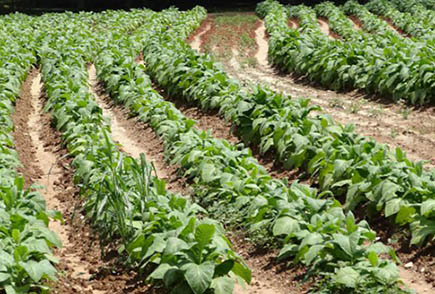Tobacco is extremely sensitive to auxin or growth regulator herbicides. Even minute doses can seriously injure the crop. Off-target damage to tobacco often results in expensive fines and/or lawsuits, lost productivity for growers, and bad publicity for the industry. Herbicide damage can lead to poor leaf quality, reduced yield, and possible rejection by buyers. Fortunately, preventive steps can be taken to avoid these problems.
(For more information, refer to Extension publication Preventing Off-target Herbicide Problems in Tobacco Fields W290-A)
- Herbicide Selection — Although highly effective on several broadleaf weeds in pastures and rights-of-way, the auxin or growth regulator herbicides can damage sensitive crops if not used properly. The characteristics of these herbicides determine which product to use in different situations.
- Volatile herbicides — change from a liquid to gas or vapor and move away from the target. Typically, dicamba and 2,4-D are more volatile than aminopyralid or picloram.
- Persistence of herbicides — The persistence of herbicides can affect future plans for a field. While dicamba and 2,4-D are highly active on tobacco even in minute doses, these materials are relatively non-persistent in soil and in treated pasture grasses and hay. This is not the case with aminopyralid or picloram. Both of these herbicides can stay active in soil, pasture grass and hay for a year or longer.
- Water Solubility — Picloram is more soluble than aminopyralid and therefore more likely to be moved off-site by runoff.
- Prevention of Drift — Several factors can contribute to herbicide drift to sensitive areas. physical and vapor, can occur. (Refer to the section “Spray Today?” in this website)
- Physical Drift — can occur when the herbicide is blown away from the target area on windy days and/or in runoff after a hard rain. It is important to monitor weather conditions several days prior to and after spraying to prevent physical drift.
- Vapor Drift — is the movement of spray vapor away from the target after the herbicide has been deposited on the target. It is mainly influenced by air temperature, but also by relative humidity (RH) and herbicide formulation.
- Field Selection — The location, characteristics and history of a field influence future management strategies. Before planting tobacco, research the history of the field to see if it has been treated with any persistent herbicides in the past three years.
- Movement of Cattle and Handling of Manure — Cattle that graze on pastures treated with persistent herbicides (aminopyralid and picloram) should be monitored carefully. Aminopyralid and picloram remain intact in treated pasture grasses or hay, and when these forages are consumed by animals, the chemical passes through their digestive and urinary systems without change and into the manure and urine.
- Handling of Treated Hay — When purchasing hay, producers should know the origin of the hay and whether it was treated with persistent pasture herbicides.
- Monitoring Results — Producers are encouraged to assess the performance of herbicides in pastures and hay fields. Tracking results will guide future decisions for weed control. It is important to keep a log of all applications with dates, products, field locations and weather conditions.
(For more information refer to Extension publication Diagnosing Suspected Off-target Herbicide Damage to Tobacco, W290-B.)
Diagnosing herbicide injury in tobacco can be difficult because many pasture herbicides mimic the plant hormone auxin, and symptoms can be quite similar. The images and descriptions seen here are intended to highlight characteristic symptomology of each of these broadleaf herbicides on tobacco.
The following are descriptions of commonly observed symptoms resulting from exposure to synthetic auxin herbicides:
- Hooding — Downward folding and cupping of entire leaves.
- Curling — Folding of edge of leaf margins.
- Epinasty — Twisting, bending, and/or elongation of stems and leaf petioles.
- Chlorosis — Yellowing or whitening of leaves resulting from loss of chlorophyll.
- Necrosis — Browning of tissue resulting from cell death.
